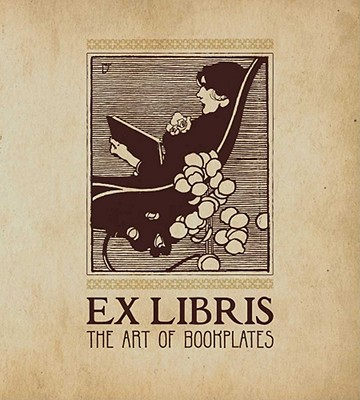Many of the great individual titles of the past two millennia are discussed as well as the range of book types and formats that have emerged in the last few hundred years, from serial and dime novels to paperbacks, children’s books, and Japanese manga. The volume ends with a discussion of the digital revolution in book production and distribution and the ramifications for book lovers, who can’t help but wonder whether the book will thrive—or even survive—in a form they recognize.
(page photos are from selectism.com)
Endlessly diverse and appealing, bookplates (also called ex libris, Latin for "from the books of") are small decorative labels to be pasted inside a book's cover to express personal ownership. Originating in their modern printed form in 16th-century Germany, where books were highly valuable and treasured, bookplates became an art form practiced by artists across Europe and beyond. This book traces the fascinating evolution of bookplate design over time and across national boundaries, showcasing 100 key examples of ex libris art.
In the early 1500s, Albrecht Dürer and other German engravers and printmakers began to create highly decorative bookplates, often featuring armorial devices and coats of arms for wealthy individuals and institutions. As the fashion for ornamental bookplates spread, distinctive national styles evolved. Nearly every conceivable design element—from cupids to scientific instruments, portraits, and landscapes—served to decorate personal bookplates. This volume explores the various sources of ex libris inspiration, including designs by C. R. Ashbee, Walter Crane, Aubrey Beardsley, Eric Gill, and Rudyard Kipling, as seen in the books of Frederic Leighton, Calvin Coolidge, and many others. Book lovers and art enthusiasts alike will delight in this treasury of bookplate art and lore.
(page photos are from selectism.com)
Endlessly diverse and appealing, bookplates (also called ex libris, Latin for "from the books of") are small decorative labels to be pasted inside a book's cover to express personal ownership. Originating in their modern printed form in 16th-century Germany, where books were highly valuable and treasured, bookplates became an art form practiced by artists across Europe and beyond. This book traces the fascinating evolution of bookplate design over time and across national boundaries, showcasing 100 key examples of ex libris art.
In the early 1500s, Albrecht Dürer and other German engravers and printmakers began to create highly decorative bookplates, often featuring armorial devices and coats of arms for wealthy individuals and institutions. As the fashion for ornamental bookplates spread, distinctive national styles evolved. Nearly every conceivable design element—from cupids to scientific instruments, portraits, and landscapes—served to decorate personal bookplates. This volume explores the various sources of ex libris inspiration, including designs by C. R. Ashbee, Walter Crane, Aubrey Beardsley, Eric Gill, and Rudyard Kipling, as seen in the books of Frederic Leighton, Calvin Coolidge, and many others. Book lovers and art enthusiasts alike will delight in this treasury of bookplate art and lore.




No comments:
Post a Comment